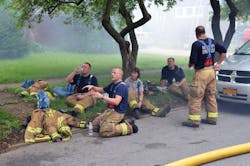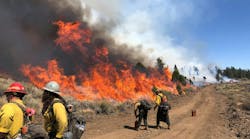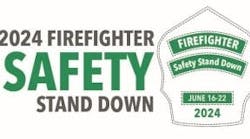Our department just finished another round of our annual firefighter physicals under National Fire Protection Association (NFPA) 1582: Standard on Comprehensive Occupational Medical Program for Fire Departments. This is our eighth year of doing physicals on all of our members to determine their fit-for-duty status and also conducting annual respiratory fit tests. Believe me, it was not easy to get this started and quite frankly it has not been easy to maintain. Why, you ask?
First, just like many other situations, people think we are infringing on their personal rights. Second, they believe something will be found to prevent them from being a firefighter. Third, I believe that people are embarrassed to find out and to also be told that they have a problem that they ALREADY knew they had. Last, it is quite expensive to provide a very thorough physical on each member. So why do we do it? Allow me to explain.
About 10 years ago, the NFPA took a very hard look at the physical well-being of firefighters and found that many of us are not “fit for duty.” Recommendations were made, standards written and guidelines published. Sadly, many departments still do not follow the guidelines to determine whether their members are able to safely and successfully perform their duties. This negligence applies to career and volunteer departments alike, with both sides having substantial wins and losses.
We found that cardiovascular disease is a major issue killing our team members along with other health factors, such as diabetes, kidney disease, hypertension, obesity and lack of physical exercise. The result? Increased deaths in the fire service. Just look at the causes of firefighter fatalities cited in National Institute for Occupational Safety and Health (NIOSH) reports and U.S Fire Administration (USFA) line-of-duty death announcements.
NFPA 1582 was developed to provide a comprehensive roadmap for fire departments to assess firefighter readiness to perform essential job functions, focusing on strength and aerobic readiness for full-duty status. The standard considers that being not fit for duty can prevent a firefighter from safely performing essential tasks such as firefighting, while wearing self-contained breathing apparatus (SCBA), climbing stairs while wearing turnout gear and carrying equipment weighing 50 pounds or more, victim search and rescue, advancing charged hoselines, climbing ladders and otherwise just functioning as sea firefighter.
In light of the findings and other research, we still struggle to implement change. Members of the fire service may have more control over their health and line-of-duty-death statistics than they realize. Sometimes, it is not feasible to do because of tight budgets, lack of funding, contracts, beliefs or even time. Individually, every one of us can make a difference. These deaths need not be accepted as inevitable. With the proper interventions, the number of such deaths and illnesses can be decreased.
“Clogged arteries are a societal disease and heart disease primarily a disease of choice, of lifestyle,” says Richard Milani, director of preventive cardiology at the Ochsner Institute in New Orleans. He was commenting on a study headed by Dr. Salim Yusuf, head of the Population Health Research Institute at McMaster University in Hamilton, Ontario. Dr. Yusuf and his colleagues identified nine risk factors that “account for 90% of the heart disease in every population on earth: smoking, high blood pressure, diabetes, obesity, stress, a desk job (sedentary lifestyle), a diet rich in processed foods and low in fruit and fiber, fats and ‘failure to take a thimbleful of alcohol.’” These are all things that we know, that we tell others and that we think won’t happen to us! So the question to you, the firefighter, is this: What are you doing to avoid becoming a statistic and letting your team down?
Many of us are at risk and, although we may already know it, we are not willing to do anything about it. In 2010, I decided to make a change. I started eating healthy following a fellow firefighter’s book, The Engine 2 Diet by Rip Esselstyn, which describes natural and clean eating. Along with eating healthy, I started to walk inside the fire station bays.
After a few weeks of walking laps, I ran a few and walked a few. Next thing that I knew, I had just run a mile! Three months later, I ran my first 5K race and I have never looked back. After another three months, at the age of 41, I was in the best shape of my life.
What I learned was that not only could I do it for me, but I did it for my department. I was making my SCBA last longer, carrying equipment better and working more efficiently and safely at emergency scenes. The question now becomes, since you are aware of your deficiencies, how do you plan to explain your actions when it affects someone else? Are you prepared to let down the team, the public that is counting on you and your own family?
Selfishly, I think many are and we need to make a change, myself included. Now before anyone gets mad, let me remind you that we all have weaknesses and physical limitations; I know that I certainly do. The difference is that we must know when to say “no” or “I cannot do that.” This leads to another problem and that is you are needed. You are part of the team. You are possibly the difference between success and failure. Make the change and start now even if your department does not have the ability to do it for you. Do it yourself!
Here is how you can start. The NFPA recommends that fire departments phase in a mandatory wellness/fitness program for firefighters, institute an annual physical performance (physical ability) evaluation to ensure firefighters are physically capable of performing the essential job tasks of structural firefighting and “ensure that firefighters are cleared for duty by a physician knowledgeable about the physical demands of firefighting, the personal protective equipment used by firefighters and the various components of NFPA 1582.” (See Rich Meyer’s Firefighter Fitness column on page XX.)
You can make progress by incorporating physical activity into everyday life. For example, use the stairs instead of the elevator. Start with one flight of stairs and gradually build up to more. Park a few blocks from wherever you go and walk the rest of the way. If you take public transportation, get off a stop or two early and walk a few blocks. While working, take frequent activity breaks to get up and stretch, walk around and give your muscles and your mind a change of pace. Instead of eating that extra snack, take a brisk stroll around the neighborhood or get on the treadmill. Do housework, gardening and yard work at a more vigorous pace. Exercise burns calories, builds stamina, improves balance, strengthens your lungs and boosts the way you feel. All this together will improve your physical health and that of the department.
Those are the simple ones to implement but the real change will occur in your lifestyle. This is not a simple fix. This is not a diet. This is not “I want to lose X pounds.” This must be a lifestyle change.
here are some tips from the American Heart Association’s Dietary and Lifestyle Guidelines: Consume an overall healthful diet. Eat a wide variety of fruits and vegetables (not fruit juices), especially those that are deeply colored (spinach, carrots, peaches and berries). Prepare fruits and vegetables with little added saturated or trans-fats (partially hydrogenated fats), salt and sugar. Choose whole-grain, high-fiber foods. Eat at least two servings a week of fish, especially those relatively high in omega-3 fatty acids (e.g., salmon, trout and herring); avoid mercury-contaminated fish such as shark, swordfish, king mackerel and tilefish. Limit daily sodium intake to no more than 2,300 mg. Middle-aged and older adults, African Americans and those with hypertension should consume no more than 1,500 mg of sodium daily. Limit your intake of saturated fat (less than 7% of calories), trans fats (less than 1% of calories) and cholesterol by choosing lean meats, vegetables and fat-free (skim) and low-fat (1%) dairy products. Minimize your intake of beverages and foods with added sugars. Increase your awareness of the calorie content of foods for portions you typically consume and of your daily caloric requirements. Avoid tobacco products. Limit alcohol intake to not more than one drink per day for women and two drinks per day for men (one drink equals a 12-ounce beer, four ounces of wine, 1½ ounces of 80-proof distilled spirits or one ounce of 100-proof spirits). Maintain a healthy body weight; balance calories consumed with calories burned. Set a goal of at least 30 minutes of physical activity daily.
This must be a lifestyle change you are willing to make. I did it in 2010 and lost 45 pounds by eating healthy and exercising regularly. I was in the prime of my life and the best shape since high school. You can do it too.
Nothing comes easy. Being out of condition did not happen to you overnight and so it will take time to fix. Focus on the positive and make the change. We need you! Your community and your department need you! After all, that set of gear you wear adds 50 pounds on average to you. That hose you are carrying or dragging weighs another 15 to 30 pounds and, oh yeah, you are on restricted breathing wearing your SCBA. I didn’t even mention climbing, crawling, dragging, working in super-heated atmospheres, stress and anxiety. Do you think all this puts a burden on your physical health? Should you be better prepared for the fire service?
Make the change, endorse firefighter fitness and make a difference. Maybe your personal physical health should not even be a concern of the department; maybe the burden should be all yours.
Lieutenant Scott Goodwin
Ballville Township Fire Department
Fremont, OH
The writer is a member of the Northwest Ohio Urban Search and Rescue (USAR) Technical Rescue Team for Region 1 Ohio. He holds a bachelor’s degree in safety engineering from Fairmont State University and is a Certified Occupational Safety Specialist, OSHA instructor, Mine Safety and Health instructor, first aid/CPR instructor and general safety instructor. He is director of CSTS Global, a safety consultancy serving emergency organizations and industry. He can be contacted at [email protected] or follow him at http://twitter.com/safetyscott and http://blog.confinedspacetrainingservices.com/.
CORRECTION
The credit for a photo on page 56 of the March 2014 issue, showing a pall of smoke covering a freeway, was inadvertently omitted. The photographer is Rick McClure.
We welcome feedback, views, reactions and observations. Please send letters to Speak Up, Firehouse Magazine, 3 Huntington Quadrangle, Suite 301N, Melville, NY 11747; fax them to 631-845-2741; or e-mail them to [email protected]. Letters may be edited for space and clarity. The opinions expressed here are solely those of the undersigned and do not represent endorsement by Firehouse® Magazine.






